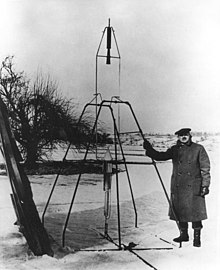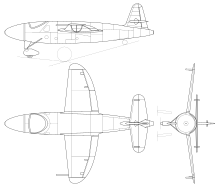Liquid-propellant rocket
Indeed, overall thrust to weight ratios including a turbopump have been as high as 155:1 with the SpaceX Merlin 1D rocket engine and up to 180:1 with the vacuum version.In simpler, small engines, an inert gas stored in a tank at a high pressure is sometimes used instead of pumps to force propellants into the combustion chamber.For storable ICBMs and most spacecraft, including crewed vehicles, planetary probes, and satellites, storing cryogenic propellants over extended periods is unfeasible.Consequently, to improve handling, some crew vehicles such as Dream Chaser and Space Ship Two plan to use hybrid rockets with non-toxic fuel and oxidizer combinations.Injectors can be as simple as a number of small diameter holes arranged in carefully constructed patterns through which the fuel and oxidizer travel.The speed of the flow is determined by the square root of the pressure drop across the injectors, the shape of the hole and other details such as the density of the propellant.Rotational motion is applied to the liquid (and sometimes the two propellants are mixed), then it is expelled through a small hole, where it forms a cone-shaped sheet that rapidly atomizes.To prevent these issues the RS-25 injector design instead went to a lot of effort to vaporize the propellant prior to injection into the combustion chamber.A number of tradeoffs arise from this selection, some of which include: Injectors are commonly laid out so that a fuel-rich layer is created at the combustion chamber wall.Soviet search teams at Peenemünde found a German translation of a book by Tsiolkovsky of which "almost every page...was embellished by von Braun's comments and notes.[18] A total of 100 bench tests of liquid-propellant rockets were conducted using various types of fuel, both low and high-boiling and thrust up to 300 kg was achieved.[19][18] During this period in Moscow, Fredrich Tsander – a scientist and inventor – was designing and building liquid rocket engines which ran on compressed air and gasoline.On 17 August 1933, Mikhail Tikhonravov launched the first Soviet liquid-propelled rocket (the GIRD-9), fueled by liquid oxygen and jellied gasoline.At RNII Gushko continued the development of liquid propellant rocket engines ОРМ-53 to ОРМ-102, with ORM-65 [ru] powering the RP-318 rocket-powered aircraft.[28][29] Historians of early rocketry experiments, among them Max Valier, Willy Ley, and John D. Clark, have given differing amounts of credence to Paulet's report.[28][32][33][34][35] Paulet was later approached by Nazi Germany, being invited to join the Astronomische Gesellschaft to help develop rocket technology, though he refused to assist after discovering that the project was destined for weaponization and never shared the formula for his propellant.[36][37] According to filmmaker and researcher Álvaro Mejía, Frederick I. Ordway III would later attempt to discredit Paulet's discoveries in the context of the Cold War and in an effort to shift the public image of von Braun away from his history with Nazi Germany.[38] The first flight of a liquid-propellant rocket took place on March 16, 1926 at Auburn, Massachusetts, when American professor Dr. Robert H. Goddard launched a vehicle using liquid oxygen and gasoline as propellants.[40] In Germany, engineers and scientists became enthralled with liquid propulsion, building and testing them in the late 1920s within Opel RAK, the world's first rocket program, in Rüsselsheim.The main purpose of these tests was to develop the liquid rocket-propulsion system for a Gebrüder-Müller-Griessheim aircraft[42] under construction for a planned flight across the English channel.[44] Max Valier's (via Arthur Rudolph and Heylandt), who died while experimenting in 1930, and Friedrich Sander's work on liquid-fuel rockets was confiscated by the German military, the Heereswaffenamt and integrated into the activities under General Walter Dornberger in the early and mid-1930s in a field near Berlin.[46] The only production rocket-powered combat aircraft ever to see military service, the Me 163 Komet in 1944-45, also used a Walter-designed liquid rocket engine, the Walter HWK 109-509, which produced up to 1,700 kgf (16.7 kN) thrust at full power.After World War II the American government and military finally seriously considered liquid-propellant rockets as weapons and began to fund work on them.
- Liquid rocket fuel .
- Oxidizer .
- Pumps carry the fuel and oxidizer.
- The combustion chamber mixes and burns the two liquids.
- Combustion product gasses enter the nozzle through a throat.
- Exhaust exits the rocket.







Rocket-powered aircraftLiquid rocket fuelOxidizercombustion chambernozzlerocket engineliquid propellantssolid propellantsspecific impulse (Isp)monopropellant rocketsbipropellant rocketsTripropellant rocketshybrid rocketssolid rocketliquid hydrogenliquid oxygencryogenic rocket enginethrottleablequality managementspecific impulseSpace ShuttleFalcon 9center of massgauge pressureguidance systempogo oscillationullage motorshydrogenTurbopumpsCryogenic propellantsSpace Shuttle Columbia disastersolid rocketsnozzlespressure to prevent vaporizationreciprocating pumpsthrust to weight ratiosMerlin 1Ddelta-vpyrotechnic igniterpropellantrocket engine nozzlepressure-fedpump-fedengine cyclesturbopumpLiquid rocket propellantSpace Launch Systemcore stageAriane 5Delta IVAres ISaturn Vsecondthird stagesSaturn IBSaturn ICentaurLong March 3Long March 5Long March 8GSLV Mk-IIGSLV Mk-IIIliquid methaneliquefied natural gasRaptorPropulsion Cryogenics & Advanced DevelopmentProject MorpheusoxygenSpace Shuttle external tankColumbiadestructionatmospheric reentryreusable launch systemsfirst stageZenit rocketTitan IAtlas rocketsFalcon 1Long March 6Long March 7ethanolGermanWorld War IIRedstonegasolineRobert Goddardcarbon monoxideZirconiaNMUSAFhypergolicT-StoffC-StoffHWK 109-509Messerschmitt Me 163Ba 349 NatterNitric acidSovietMiG I-270dinitrogen tetroxideShahab-5North KoreaTaepodong-2High-test peroxideBlack ArrowHydrazinered fuming nitric acidMIM-3 Nike AjaxProtonLong March 2ShenzhouAerozine 50Titans 2–4lunar moduleservice moduleVoyager 1Voyager 2MonomethylhydrazineSpace Shuttle orbiterorbital maneuvering systemReaction control systemSpaceXDragon spacecraftstorablecarcinogenicDream ChaserSpace Ship Two